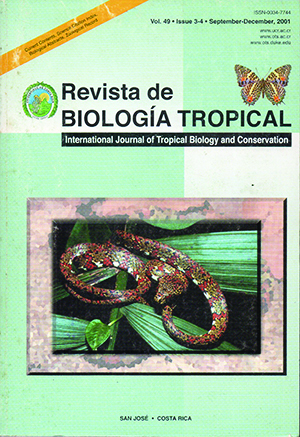Resumen
Se estudió el uso de hábitat por una tropa de C. capucinus en una zona de agricultura durante la estación seca tardía (Marzo-Abril 1994) en el noroeste de Costa Rica. Los bosques riparios, canales de palmas y cercas de árboles vivos contaron con el 82 % de las observaciones, significantemente más que los otros seis hábitats presentes. La tropa de estudio consumió 24 especies de plntas y cinco animales. La alimentación se concentró en la palma de aceite Africana introducida (Elaeis guineensis) (33.6 %) y en mango (Mangifera indica) (27.2 %), encontrados principalmente en los canales de palmas y huertos de mango respectivamente. La tropa descansó entre las 0930-1330 hr y se alimentó y movió entre las 0530-0930 hr y 1330- 1730 hr. Las cercas de árboles vivos fueron usadas como rutas de paso o corredores y menos intensamente para otras actividades.##plugins.facebook.comentarios##

Esta obra está bajo una licencia internacional Creative Commons Atribución 4.0.
Derechos de autor 2001 Revista de Biología Tropical
Descargas
Los datos de descargas todavía no están disponibles.


